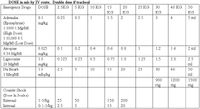Cardiopulmonary cerebral resuscitation (Proceedings)
Cardiac arrest is a life-threatening emergency which must be recognized and treated IMMEDIATELY!
Recognition of Cardiopulmonary Arrest
• Unconscious- nonresponsive
• Lack of pulse or heartbeat
• Lack of breathing
• Other signs
Prognosis
• Most will die
• Some can be resuscitated
• Some should be resuscitated
Basic Life Support - CPR
• Recognition of arrest
• Call for help
• Verify and secure patent airway - Positive pressure ventilation with 100% oxygen if available
• Cardiac massage at 90-120/minute with choice of technique based on pulse quality
Cardiac arrest is a life threatening emergency which must be recognized and treated IMMEDIATELY!!
Cardiopulmonary Resuscitation
a. Airway
b. Breathing
c. Circulation
Airway
• Visual Inspection
Breathing
• Anesthesia Circuit or Mouth to tube or muzzle or Resuscitation Bag AMBU Bag
• Breathing Rate of 8-12 per minute
Circulation (External Cardiac Compression) optimize technique
• Technique - guided by monitoring equipment
• Use pulse oximeter for pulse wave-form as well as for hemoglobin saturation
• Use capnometer for evidence of tissue perfusion as well as for appropriate ventilation
• Circulation (Internal Cardiac Compression)
• Advantages: efficient, effective (C.O. 80% open vs. 30% closed)
• Disadvantages are substantial: not quick enough, traumatic (patient, owner, & personnel), poor results
• Reserve Internal Cardiac Compression for very limited situations
Newer Cardiovascular Pharmacology in CPR
• Magnesium therapy in CPR - Many causes of hypomagnesemia in patients at risk:
GI and renal losses increased in the critically ill, diuretics, diabetic ketoacidosis, hyperthyroidism, primary hyperparathyroidism, cholestatic liver disease, hypothermia, blood transfusions, etc.
Emperical administration of 100mg/kg MgSO4 over 5-10 min improves defibrillation, improves chances of resuscitation and ultimate recovery. Proper use of cardiovascular pharmacology during resuscitation is based on identification of the type of arrest...
1. Ventricular or Complete Asystole
• "Flat line" ECG - Full vagolytic doses of Atropine are recommended for asystole & bradycardic arrests
• May Result in...
• Electrical-mechanical dissociation
• Ventricular tachycardia
• Ventricular fibrillation
• Normal sinus rhythm
• Recurring asystole
• Sinus bradycardia
2. Ventricular Fibrillation
• May Result in...
• Normal sinus rhythm
• Ventricular tachycardia
• Recurring ventricular fibrillation
• Asystole
3. Pulseless Electrical Activity (PEA) AKA Electrical-Mechanical Dissociation (EMD)
• Therapies for PEA - Continued BLS plus:
• Bicarbonate
• Calcium (controversial - detrimental)
• Dopamine, Ephedrine, Dobutamine (or other inotropes)
• May Result in...
• Continued PEA
• Asystole
• Fibrillation
Areas of Current Controversy in CPR
• Alternative techniques for compression & ventilation
• Mechanisms of forward blood flow
• Reconsideration of CPR dogma
• Revival of earlier techniques
• Drug therapy to limit cardiac & cerebral injury
Alternative Techniques- Compression & Ventilation
• "High- Impulse" CPR
• Cardiac Compression with Abdominal Compression or Abdominal Binding
• Simultaneous Cardiac
• Compression & Ventilation
• Body Position (guided by pulse)
• Benefits Associated with Alternative Techniques:
• Increased Carotid & Cerebral Blood Flow
• Compression with simultaneous ventilation
• Compression with abdominal binding
• Interposed abdominal compression CPR
• Long duration compression
• However, lack of demonstrated benefit - Reserve for limited situations
• Mechanisms of Forward Blood Flow
• Is the human a good model for the dog?
• Animal research and clinical CPCR data reconsidered for new approaches in resuscitation
Species differences
Different "types" of arrest
• V-fib predominates in human arrest - Emphasis on electrical defibrillation
• PEA (EMD) predominates in dogs and cats - Unfortunately, more refractory to CPR
• Revival of Earlier Techniques - Should CPR follow the "ABC" sequence?
• Residual oxygen may be sufficient - Evidence from research in dogs and pigs
• Mouth to muzzle or tube provides less oxygen than does aspired air in agonal gasps!
• Perhaps "CAB" is a better sequence in CPR! Especially for bystander CPR
• Earlier Techniques Reconsidered
• Emergency thoracotomy for internal CPR -
• Long discredited as a destructive and futile procedure - Thoracotomy delays forward blood-flow
• ("blood on your hands" and a dead patient)! Now being reconsidered in veterinary CPR...
• Open chest CPR must be done correctly with an emphasis also on speed! Stay tuned for results.
Drug Therapy to Limit Cardiac & Cerebral Injury
Cerebral Events with "Normothermic Complete Ischemia"
• Depletion of brain oxygen & unconsciousness within 15 seconds
• Brain glucose energy stores depleted within 15 minutes
• Individual cerebral neurons may survive 20-60 minutes
Cardiopulmonary Arrest
• Most will die - Some can be resuscitated - Some should be resuscitated
• Resusci-Dog and Resusci-Cat for CPCR Training
Cardiopulmonary Resuscitation

Table 1 : Dose in mls by IV route. Double dose if tracheal.
Cardiopulmonary Resuscitation

Table 2 : DOSE in mls by IV route. Double dose if tracheal









